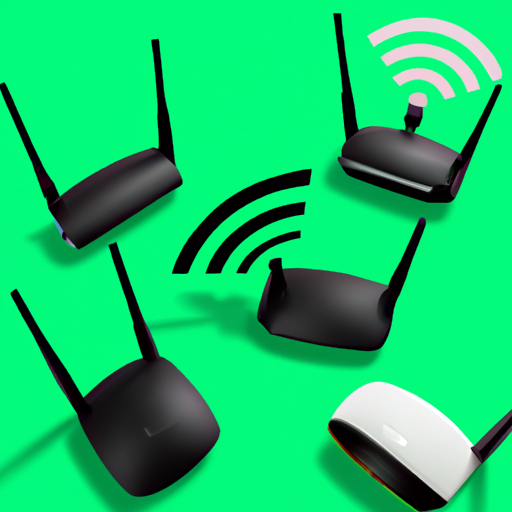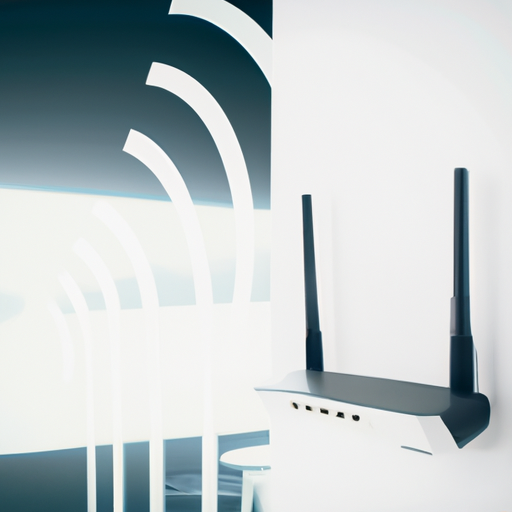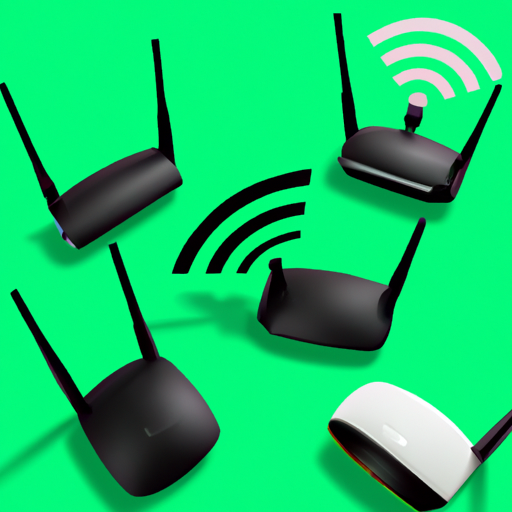In this article, we will explore the top gadgets that can help enhance Wi-Fi coverage in a spacious residence. If you’re tired of dead zones and weak signals, fret not, because we’ve got you covered. Discover the solutions that can boost your Wi-Fi signal and ensure seamless connectivity throughout your home. So, let’s dive in and find out how you can improve your Wi-Fi experience in a large living space.
Wireless Range Extenders
Importance of wireless range extenders in enhancing Wi-Fi coverage
Having a weak Wi-Fi signal can be frustrating, especially in a large residence where the signal often struggles to reach all areas. This is where wireless range extenders come in handy. These devices amplify and extend the Wi-Fi signal, ensuring that every corner of your home has a strong and reliable connection.
A wireless range extender acts as a bridge between your existing Wi-Fi router and your devices, allowing the signal to reach areas that were previously out of range. By placing a range extender in a strategic location, you can eliminate dead spots and ensure that all of your devices can connect to the internet seamlessly.
Different types of wireless range extenders available in the market
There are several types of wireless range extenders available in the market, each with its own set of features and capabilities. Here are a few popular options:
-
Plug-In Range Extenders: These range extenders are compact and easy to install. They simply plug into a power outlet, making them ideal for small spaces and apartments.
-
Desktop Range Extenders: These range extenders are larger in size but offer stronger and more reliable coverage. They usually have multiple antennas for better signal reception and transmission.
-
Outdoor Range Extenders: If you have a large outdoor area that requires Wi-Fi coverage, outdoor range extenders are the way to go. These weatherproof devices are designed to withstand various outdoor conditions and can extend the Wi-Fi signal to your backyard, patio, or garden.
Features to consider when choosing a wireless range extender
When selecting a wireless range extender, there are a few key features to keep in mind:
-
Compatibility: Ensure that the range extender is compatible with your existing Wi-Fi router. Most range extenders are designed to work with all major router brands, but it’s always worth double-checking.
-
Dual-Band or Tri-Band: Dual-band range extenders operate on both the 2.4GHz and 5GHz frequencies, providing faster speeds and better performance. Tri-band range extenders, on the other hand, have an additional 5GHz band, allowing for even more devices to connect simultaneously without a drop in performance.
-
Signal Strength: Look for a range extender with high signal strength, indicated by the number of antennas it has. More antennas generally mean better signal reception and transmission.
-
Easy Setup: Opt for a range extender that offers a simple and straightforward setup process. Many range extenders come with companion mobile apps that guide you through the installation process, making it hassle-free for even the least tech-savvy individuals.
-
Ethernet Ports: If you require a wired connection for certain devices, consider a range extender with Ethernet ports. These ports allow you to connect devices directly to the range extender, ensuring a stable and reliable internet connection.
Mesh Wi-Fi Systems
Advantages of using mesh Wi-Fi systems for large residences
Mesh Wi-Fi systems have gained popularity in recent years, especially for larger residences. Unlike traditional Wi-Fi routers and range extenders, mesh systems consist of multiple nodes that work together to create a single, seamless Wi-Fi network. Here are some advantages of using mesh Wi-Fi systems:
-
Improved Coverage: Mesh systems use multiple nodes strategically placed throughout your home to create a strong and consistent Wi-Fi signal. This ensures that every corner of your residence is covered, eliminating dead spots and weak signals.
-
Seamless Roaming: With a mesh system, you can move around your home without experiencing any interruptions or drops in Wi-Fi connectivity. As you move from one node to another, your device seamlessly connects to the strongest and closest node, ensuring a smooth browsing or streaming experience.
-
Easy Expansion: If you have a particularly large residence or plan on expanding your Wi-Fi coverage in the future, mesh systems can easily accommodate your needs. You can simply add more nodes to the system, extending the coverage without any degradation in performance.
-
Smart Home Integration: Many mesh Wi-Fi systems come with smart home integration capabilities. They can connect to other smart devices in your home, allowing you to control and manage them through a single app. This adds convenience and enhances the overall smart home experience.
Key components and functionality of mesh Wi-Fi systems
A typical mesh Wi-Fi system consists of the following components:
-
Router or Base Station: This is the main node of the mesh system that connects to your existing modem or internet source. It serves as the central hub and controls the distribution of the Wi-Fi signal to the other nodes.
-
Nodes: Nodes are additional devices that you scatter around your home to extend the Wi-Fi coverage. These nodes communicate with each other and the router to create a seamless network.
-
Mobile App: Most mesh systems come with a companion mobile app that allows you to set up and manage your network easily. Through the app, you can monitor connected devices, change network settings, and perform firmware updates.
-
Automatic Band Steering: Mesh systems use a technology called automatic band steering to optimize device connections. This feature ensures that devices are connected to the frequency band that provides the best performance, whether it’s the 2.4GHz or 5GHz band.
Top-rated mesh Wi-Fi systems in the market
There are several top-rated mesh Wi-Fi systems available in the market, each with its own strengths and features. Here are a few options to consider:
-
Google Nest Wifi: The Google Nest Wifi system offers excellent coverage and easy setup. It also integrates well with other Google smart home devices.
-
Netgear Orbi: Netgear Orbi is known for its impressive coverage and performance. It’s a great choice for large homes with multiple stories or complex layouts.
-
Eero Pro Mesh Wi-Fi System: Eero Pro excels in delivering reliable and fast Wi-Fi coverage. It offers advanced security features and is compatible with popular voice assistants.
-
TP-Link Deco: TP-Link Deco provides strong Wi-Fi coverage and is highly customizable. It’s a budget-friendly option without compromising on performance.
Selecting the right mesh Wi-Fi system depends on your specific needs and budget. Consider factors such as your residence size, number of devices, and desired features when making a decision.

Wi-Fi Signal Boosters
Understanding how Wi-Fi signal boosters improve coverage
Wi-Fi signal boosters, also known as repeaters or amplifiers, are devices that enhance and extend the reach of your Wi-Fi signal. They work by receiving the existing Wi-Fi signal from your router and retransmitting it at a higher power level, effectively amplifying the signal and extending its coverage area.
Wi-Fi signal boosters can be particularly useful in large residences where the router’s signal struggles to reach certain areas. By placing a signal booster in a strategic location, you can eliminate dead zones and ensure a strong and reliable Wi-Fi connection throughout your home.
Types of Wi-Fi signal boosters and their features
There are several types of Wi-Fi signal boosters available in the market, each with its own features and capabilities. Here are a few common types:
-
Single Band Boosters: These boosters operate on a single Wi-Fi frequency band, typically 2.4GHz. They are suitable for basic internet usage and offer a cost-effective solution for improving Wi-Fi coverage.
-
Dual-Band Boosters: Dual-band boosters operate on both the 2.4GHz and 5GHz frequency bands. They provide better performance and faster speeds, making them ideal for streaming, gaming, and other bandwidth-intensive activities.
-
Plug-In Boosters: Plug-in boosters are compact devices that plug directly into a power outlet. They are easy to install and require minimal setup. These boosters are suitable for small to medium-sized residences.
-
Outdoor Boosters: Outdoor boosters are designed to withstand various weather conditions and are ideal for extending Wi-Fi coverage to outdoor areas such as gardens, patios, and garages.
When selecting a Wi-Fi signal booster, consider factors such as the compatibility with your existing Wi-Fi router, the desired frequency band, and the coverage area you wish to extend.
Installation and setup process of Wi-Fi signal boosters
Installing and setting up a Wi-Fi signal booster is generally a straightforward process. Here are the general steps to follow:
-
Choose a Strategic Location: Identify an area in your home that is centrally located and where the Wi-Fi signal is still reasonably strong. This will serve as the placement spot for your signal booster.
-
Connect the Signal Booster: Establish a connection between your existing Wi-Fi router and the signal booster. This can usually be done by pressing the WPS (Wi-Fi Protected Setup) button on both devices.
-
Power on the Signal Booster: Plug in the signal booster to a power outlet in the chosen location. Once powered on, the signal booster will start amplifying and extending the Wi-Fi signal.
-
Perform a Signal Test: Use a Wi-Fi analyzer app or tool to check the strength and coverage of the extended Wi-Fi signal. This will help you fine-tune the placement of the signal booster for optimal performance.
The exact installation and setup process may vary depending on the brand and model of the Wi-Fi signal booster. Always refer to the manufacturer’s instructions for detailed guidance.
Powerline Adapters
Exploring the benefits of powerline adapters for Wi-Fi coverage
Powerline adapters provide an alternative solution for extending your Wi-Fi coverage, particularly in situations where Wi-Fi signals struggle to penetrate thick walls or multiple floors. These adapters use your home’s existing electrical wiring to transmit data signals, effectively turning any power outlet into an ethernet port.
One of the main benefits of powerline adapters is their ability to provide a wired connection to devices that are located far from your router. This can result in faster and more reliable internet connections, especially for devices that require a stable connection such as gaming consoles or smart TVs.
Different types of powerline adapters and their compatibility
There are a few types of powerline adapters available in the market, each with its own features and compatibility. Here are the main types:
-
Standard Powerline Adapters: These adapters provide a basic powerline connection between your router and other devices. They are typically designed for general internet browsing and everyday usage.
-
Powerline Wi-Fi Extenders: Powerline Wi-Fi extenders combine the functionality of a powerline adapter and a Wi-Fi range extender. They allow you to extend both wired and wireless connections to areas with poor Wi-Fi coverage.
-
Pass-Through Powerline Adapters: Pass-through powerline adapters feature an additional power socket, allowing you to plug other devices into the adapter. This prevents the loss of a power outlet and is convenient for areas with limited sockets.
When choosing a powerline adapter, ensure that it is compatible with your existing router and powerline network. Most adapters are designed to be compatible with all major router brands, but it’s always a good idea to double-check.
Installation and configuration of powerline adapters
Installing and configuring powerline adapters is relatively straightforward. Here are the general steps to follow:
-
Pair the Adapters: Plug one adapter into a power outlet near your router and connect it to the router using an Ethernet cable. Plug the second adapter into a power outlet in the area where you want to extend the wired or wireless connection.
-
Pair the Adapters: Most powerline adapters have a pairing button or process that allows them to establish a secure and encrypted connection. Follow the manufacturer’s instructions to pair the adapters.
-
Configure the Wi-Fi Extender (if applicable): If you are using a powerline Wi-Fi extender, connect a device to the extender using an Ethernet cable or the provided Wi-Fi network. Access the extender’s configuration interface through a web browser and follow the on-screen instructions to configure the Wi-Fi settings.
-
Perform a Speed Test: Test the speed and stability of the extended connection using a speed test tool or app. This will help you ensure that the powerline adapters are functioning optimally.
Always refer to the specific instructions provided by the manufacturer when installing and configuring powerline adapters, as the process may vary slightly.

Router Placement Techniques
Importance of optimal router placement for improved coverage
Placing your Wi-Fi router in the right location is crucial for maximizing Wi-Fi coverage and minimizing signal interference. The location of your router can greatly impact the strength and range of the Wi-Fi signal. Here’s why optimal router placement is important:
-
Eliminating Dead Zones: Placing the router in a central location within your home ensures that the Wi-Fi signal can reach every room without significant loss. This helps eliminate dead zones – areas where the Wi-Fi signal is weak or nonexistent.
-
Reducing Signal Interference: Routers emit electromagnetic waves that can be disrupted or blocked by certain materials such as concrete walls or metal surfaces. By avoiding obstacles and interference sources, you can ensure a stronger and more reliable Wi-Fi signal.
-
Minimizing Signal Obstructions: Objects such as furniture, appliances, or large household items can absorb or block Wi-Fi signals. Placing the router in an open space with minimal obstructions allows the signal to propagate freely and reach a wider area.
Strategies for selecting the best location for a Wi-Fi router
When selecting the best location for your Wi-Fi router, consider these strategies:
-
Central Placement: Position the router as close to the center of your home as possible. This helps evenly distribute the Wi-Fi signal, reducing the likelihood of dead zones in far-reaching areas.
-
Elevation: Place the router at an elevated position, such as on a shelf or mounted on a wall. This helps the signal propagate vertically, covering multiple floors if needed.
-
Avoid Obstacles: Keep the router away from thick walls, metal surfaces, and large appliances that can interfere with the Wi-Fi signal. If possible, place the router in an open area with minimal obstructions.
-
Keep Away from Electronics: Electronics like cordless phones, baby monitors, and microwaves can emit signals that interfere with Wi-Fi. Try to keep the router away from such devices to minimize signal interference.
-
Consider Antenna Orientation: If your router has adjustable antennas, experiment with different orientations. Position the antennas perpendicular to each other, as this can help distribute the Wi-Fi signal more effectively.
Tips to optimize router settings for better performance
In addition to optimal router placement, optimizing router settings can further improve Wi-Fi performance. Here are a few tips:
-
Choose the Right Channel: Wi-Fi routers transmit data on specific channels. Neighboring routers can cause interference if they are on the same channel. Use a Wi-Fi analyzer tool to identify the least congested channel and manually set your router to that channel.
-
Enable Quality of Service (QoS): QoS settings allow you to prioritize certain types of internet traffic. For example, you can prioritize video streaming or gaming to ensure a smooth experience even if other devices are connected to the network.
-
Update Firmware: Regularly check for firmware updates for your router and install them. Firmware updates often include performance enhancements and bug fixes that can improve your Wi-Fi experience.
-
Secure Your Network: Set a strong password for your Wi-Fi network to prevent unauthorized access. If multiple neighbors are using the same channel, encryption can help avoid interference issues.
-
Configure Band Steering (Dual-Band Routers): Dual-band routers operate on both the 2.4GHz and 5GHz frequency bands. Enable band steering to automatically guide devices to the most suitable band based on their capabilities and proximity to the router.
Optimizing router settings may require accessing the router’s configuration interface through a web browser. Consult the router’s manual or manufacturer’s website for instructions specific to your model.
Wi-Fi Analyzers and Monitoring Tools
Role of Wi-Fi analyzers in identifying coverage issues
Wi-Fi analyzers are tools that help identify coverage issues and optimize Wi-Fi performance. They provide valuable insights into the strength of Wi-Fi signals, signal interference sources, and other essential network parameters. Here are some key roles of Wi-Fi analyzers:
-
Signal Strength Analysis: Wi-Fi analyzers measure the signal strength of various Wi-Fi networks in your vicinity. This allows you to identify dead zones, areas with weak coverage, or areas where interference is strong.
-
Channel Interference Detection: Wi-Fi networks operate on specific channels. Wi-Fi analyzers can identify neighboring networks that are on the same or overlapping channels. This helps you choose a less congested channel for your own Wi-Fi network, minimizing interference.
-
Signal-to-Noise Ratio (SNR) Measurement: Wi-Fi analyzers measure the SNR of Wi-Fi signals. SNR determines the ratio of the Wi-Fi signal strength to the ambient noise level. A higher SNR indicates better signal quality and reduces the likelihood of packet loss or data corruption.
-
Performance Testing: Some Wi-Fi analyzers offer performance testing features that allow you to measure the actual download and upload speeds of your Wi-Fi network. This helps you monitor the performance of your network and identify any bottlenecks.
Wi-Fi analyzers are invaluable tools for troubleshooting Wi-Fi coverage issues and optimizing network performance. They provide visual representations of Wi-Fi signals, making it easier to identify problematic areas and make informed decisions.
Top Wi-Fi analyzers and monitoring tools for troubleshooting
There are several Wi-Fi analyzers and monitoring tools available, each with its own set of features and capabilities. Here are a few top-rated options:
-
NetSpot: NetSpot is a powerful Wi-Fi analyzer for Windows and macOS. It offers advanced signal visualization, channel optimization, and Wi-Fi planning capabilities. NetSpot also provides in-depth network analysis and troubleshooting tools.
-
inSSIDer: inSSIDer is a popular Wi-Fi analyzer available for Windows and macOS. It provides detailed information about nearby Wi-Fi networks, including signal strength, noise levels, and channel overlappers. inSSIDer helps optimize Wi-Fi channel selection for better performance.
-
WiFi Analyzer (Android): WiFi Analyzer is a free Android app that allows you to analyze and visualize Wi-Fi networks in your area. It provides real-time signal strength measurements, channel recommendations, and a Wi-Fi signal heatmap.
-
AirPort Utility (Apple): AirPort Utility is a macOS and iOS app specifically designed for managing Apple’s AirPort routers. It provides basic Wi-Fi analysis capabilities, including signal strength monitoring, channel selection, and configuration options for optimal performance.
These are just a few examples of Wi-Fi analyzers and monitoring tools available. Each tool has its own unique features and user interface, so it’s worth exploring different options to find the one that suits your needs best.
Utilizing data from Wi-Fi analyzers for optimizing coverage
Wi-Fi analyzers provide valuable data that can help optimize Wi-Fi coverage in a large residence. By utilizing the information gathered from Wi-Fi analyzers, you can make informed decisions to improve signal strength and network performance. Here’s how you can utilize the data:
-
Identify Dead Zones: Wi-Fi analyzers can help identify areas with weak or no signal coverage. By visualizing signal strength data, you can strategically place range extenders or powerline adapters to eliminate dead zones and ensure a strong Wi-Fi signal throughout your home.
-
Optimize Channel Selection: Analyzing neighboring Wi-Fi networks and their channel occupancy can help you choose the least congested channel for your own Wi-Fi network. This reduces interference and improves overall Wi-Fi performance.
-
Monitor Signal Quality: Continuously monitor the SNR and signal quality of your Wi-Fi network using an analyzer. If the SNR drops below acceptable levels, consider adjusting the router placement or upgrading to a more powerful router or range extender.
-
Identify Interference Sources: Wi-Fi analyzers can detect non-Wi-Fi interference sources, such as cordless phones or microwave ovens, that may be affecting the Wi-Fi signal. Identifying these sources allows you to take necessary steps to minimize their impact on your Wi-Fi network.
Wi-Fi analyzers provide actionable insights that can greatly improve Wi-Fi coverage and performance. Regularly monitoring and analyzing network data can help you troubleshoot issues, make informed decisions, and optimize the Wi-Fi experience in your spacious residence.

Wi-Fi Antennas
Understanding the significance of Wi-Fi antennas in coverage
Wi-Fi antennas play a crucial role in enhancing Wi-Fi coverage and signal strength. These antennas are responsible for transmitting and receiving radio waves, allowing devices to connect to the Wi-Fi network. Understanding the significance of Wi-Fi antennas can help you optimize coverage in your spacious home.
Wi-Fi antennas come in different shapes and sizes, each designed for specific purposes. They can be internal or external to the device, and adjustable or fixed in position. By choosing the right type of antenna and positioning it correctly, you can improve Wi-Fi coverage and signal quality in your residence.
Different types of Wi-Fi antennas and their capabilities
There are several types of Wi-Fi antennas, each with its own capabilities and range. Here are a few common types:
-
Omnidirectional Antennas: Omnidirectional antennas radiate the Wi-Fi signal in all directions, providing a 360-degree coverage pattern. They are suitable for general use, offering balanced coverage in all areas surrounding the antenna.
-
Directional Antennas: Directional antennas focus the Wi-Fi signal in a specific direction, offering higher gain and longer-range coverage. They are ideal for targeting a specific area, such as an outdoor space or a distant room within your residence.
-
Dipole Antennas: Dipole antennas are commonly found in most Wi-Fi routers and devices. They consist of two rods extending outward in a V-shape, offering an omnidirectional coverage pattern.
-
Yagi Antennas: Yagi antennas are highly directional antennas that provide long-range coverage with high gain. They are often used for point-to-point communications or reaching distant areas.
It’s important to note that some Wi-Fi devices, particularly routers and range extenders, allow you to replace or upgrade the antenna. This can be useful if you require more specific coverage patterns or increased signal strength in certain areas.
Installing and positioning Wi-Fi antennas for maximum range
Proper installation and positioning of Wi-Fi antennas can significantly impact signal range and coverage. Here are some guidelines to follow:
-
Vertical Orientation: For maximum range, position the antenna vertically. This allows the Wi-Fi signal to propagate in a broader upward and downward pattern.
-
Adjustable Angle: If your antenna is adjustable, experiment with different angles to find the position that provides the best coverage. Minor adjustments can make a big difference in signal strength.
-
Avoid Obstructions: Keep the antenna clear of obstructions, such as walls, furniture, or large objects. Obstructions can weaken or block the Wi-Fi signal, reducing coverage and signal strength.
-
Consider Placement of Multiple Antennas: If your device has multiple antennas, such as some routers or mesh system nodes, position them perpendicular to each other. This can help in achieving broader coverage in different directions.
-
External Antennas: If your router or device has external antenna connectors, consider upgrading to high-gain or directional antennas. These antennas provide better signal strength and coverage, especially in specific directions or areas.
Keep in mind that Wi-Fi antennas have different design characteristics and performance capabilities. Referring to the device’s user manual or manufacturer’s recommendations for antenna installation and positioning is always recommended.
Dual-Band and Tri-Band Routers
Benefits of dual-band and tri-band routers in large residences
Dual-band and tri-band routers offer significant advantages in large residences where multiple devices are connected simultaneously. These routers operate on multiple frequency bands, providing increased bandwidth and reduced interference. Here are the benefits of dual-band and tri-band routers:
-
Improved Bandwidth: Dual-band routers operate on both the 2.4GHz and 5GHz frequency bands, while tri-band routers have an additional 5GHz band. This provides more available bandwidth, allowing multiple devices to connect without experiencing slowdowns or performance issues.
-
Less Interference: The 2.4GHz frequency band is often crowded due to the presence of many Wi-Fi networks, Bluetooth devices, and other wireless devices. By utilizing the less congested 5GHz band, dual-band and tri-band routers can minimize interference and provide a more reliable connection.
-
Separate Networks: Dual-band and tri-band routers allow you to set up separate Wi-Fi networks on each band. This can be beneficial for establishing guest networks or dedicating one network specifically for bandwidth-intensive activities such as streaming or gaming.
-
Optimal Device Allocation: Tri-band routers can intelligently allocate devices to the most suitable frequency band, based on the device’s capabilities and bandwidth requirements. This ensures that each device receives the best possible connection without impacting others.
Selecting the appropriate dual-band or tri-band router
When selecting a dual-band or tri-band router, consider the following factors:
-
Device Compatibility: Ensure that your devices support the 5GHz frequency band. Although most modern devices are compatible, it’s a good idea to double-check, especially for older devices.
-
Speed and Performance: Different routers offer varying speeds and performance capabilities. Look for routers that provide high-speed connections and support the latest Wi-Fi standards for optimal performance.
-
Security Features: Consider routers that provide advanced security features such as WPA3 encryption and built-in firewall protection. This helps safeguard your network and devices from cyber threats.
-
Parental Control and Quality of Service (QoS): If you have children or want better control over network usage, look for routers that offer parental control features. QoS settings allow you to prioritize certain types of traffic, ensuring a smooth experience for specific devices or activities.
Research different router models, read customer reviews, and compare the features and specifications before making a decision. Select a router that suits your residence size, device requirements, and budget.
Optimizing network performance with advanced router features
To further optimize network performance with your dual-band or tri-band router, consider the following advanced features:
-
Beamforming: Beamforming technology allows the router to focus and direct the Wi-Fi signal toward connected devices. This improves signal strength and coverage, especially for devices located further away from the router.
-
MU-MIMO (Multi-User, Multiple-Input, Multiple-Output): MU-MIMO enables the router to communicate with multiple devices simultaneously, rather than sequentially. This improves network efficiency and reduces latency for devices that support MU-MIMO.
-
Guest Networks: Setting up a separate guest network on your router allows visitors to connect to the internet without accessing your main network. This enhances security and prevents unauthorized access to your private network.
-
Quality of Service (QoS) Customization: Advanced routers often provide granular QoS settings, allowing you to prioritize specific devices, applications, or types of traffic. This ensures optimal performance for critical activities or devices that require a stable connection.
By utilizing these advanced features, you can enhance the performance of your dual-band or tri-band router and provide a seamless Wi-Fi experience for all connected devices in your large residence.

Wi-Fi 6 Technology
Overview of Wi-Fi 6 and its advantages for spacious homes
Wi-Fi 6, also known as 802.11ax, is the latest generation of Wi-Fi technology. It offers several advantages over previous generations, making it ideal for spacious homes with a high number of connected devices. Here’s an overview of Wi-Fi 6 and its benefits:
-
Higher Data Rates: Wi-Fi 6 supports higher data rates, allowing for faster and more efficient data transfer. This is especially beneficial for bandwidth-intensive activities such as 4K streaming, online gaming, and file transfers.
-
Increased Capacity: Wi-Fi 6 utilizes advanced technologies, such as OFDMA (Orthogonal Frequency Division Multiple Access), to increase network capacity. This enables multiple devices to transmit data simultaneously, reducing congestion and improving overall network performance.
-
Lower Latency: Wi-Fi 6 introduces a feature called Target Wake Time (TWT) that improves battery life for devices and reduces latency. TWT enables devices to determine when and how often they need to wake up to transmit or receive data, resulting in smoother streaming, gaming, and real-time applications.
-
Improved Range: Wi-Fi 6 utilizes advanced techniques, such as beamforming and MU-MIMO, to enhance signal strength and range. This means that Wi-Fi 6 routers can provide better coverage and reach areas that were previously challenging to connect.
Key features and capabilities of Wi-Fi 6 technology
The key features and capabilities of Wi-Fi 6 technology include:
-
OFDMA: OFDMA allows the router to divide a channel into multiple smaller sub-channels, enabling simultaneous data transmission from multiple devices. This increases network capacity and reduces latency.
-
MU-MIMO: Wi-Fi 6 supports MU-MIMO technology, allowing the router to communicate with multiple devices simultaneously. This improves network efficiency and ensures a reliable connection for all connected devices.
-
BSS Coloring: BSS Coloring is a feature in Wi-Fi 6 that helps reduce interference from neighboring Wi-Fi networks. It adds a color code to each Wi-Fi transmission, allowing devices to distinguish between their own network and others, resulting in less interference and congestion.
-
1024-QAM: Wi-Fi 6 introduces a higher modulation scheme known as 1024-QAM, allowing for more efficient data transfer. This results in faster Wi-Fi speeds and improved overall network performance.
Wi-Fi 6 routers and devices work together to provide a better Wi-Fi experience in terms of speed, capacity, and reliability. Upgrading to Wi-Fi 6 technology can significantly enhance coverage and performance in your spacious home.
Purchasing and setting up Wi-Fi 6 compatible devices
To take full advantage of Wi-Fi 6 technology, you’ll need to invest in Wi-Fi 6 compatible routers and devices. Here are the steps to purchasing and setting up Wi-Fi 6 devices:
-
Check Router Compatibility: Ensure that the router you plan to purchase supports Wi-Fi 6 (802.11ax). Most manufacturers clearly label their Wi-Fi 6 routers, making it easy to identify them. Check if the router has the necessary features and specifications to meet your requirements.
-
Consider Device Compatibility: While upgrading your router to Wi-Fi 6 is beneficial, you should also consider the compatibility of your devices. Wi-Fi 6 devices can take advantage of the improved features and performance offered by the new standard.
-
Set Up the Wi-Fi 6 Router: Follow the manufacturer’s instructions to set up your Wi-Fi 6 router. This typically involves connecting it to your modem or internet source, configuring the network settings, and securing the network with a password.
-
Connect Wi-Fi 6 Devices: Once the router is set up, connect your Wi-Fi 6 devices to the network. These devices will automatically take advantage of the new Wi-Fi 6 features, such as increased capacity and faster speeds.
-
Enjoy Enhanced Wi-Fi Coverage: With your Wi-Fi 6 compatible devices in place, you can now experience the benefits of improved coverage, faster speeds, and reduced latency in your spacious residence.
Keep in mind that while upgrading to Wi-Fi 6 technology can greatly enhance your Wi-Fi experience, it requires compatible devices to fully utilize its capabilities. Gradually upgrading your devices to Wi-Fi 6 compatibility ensures optimal performance throughout your home network.
Conclusion
In conclusion, enhancing Wi-Fi coverage in a spacious residence requires the right gadgets and strategies. Wireless range extenders, mesh Wi-Fi systems, Wi-Fi signal boosters, powerline adapters, and Wi-Fi antennas are all effective solutions for maximizing Wi-Fi coverage. Optimal router placement, the use of Wi-Fi analyzers and monitoring tools, and the adoption of advanced router features can further optimize coverage and performance.
When choosing the most suitable gadgets for your needs, consider factors such as the coverage area, device requirements, and budget. Each solution has its own strengths and features, so research and compare different options to make an informed decision.
By implementing the recommended gadgets and strategies, you can significantly enhance Wi-Fi coverage and ensure a strong, reliable connection throughout your spacious residence. Say goodbye to dead zones and enjoy seamless internet connectivity in every corner of your home.

